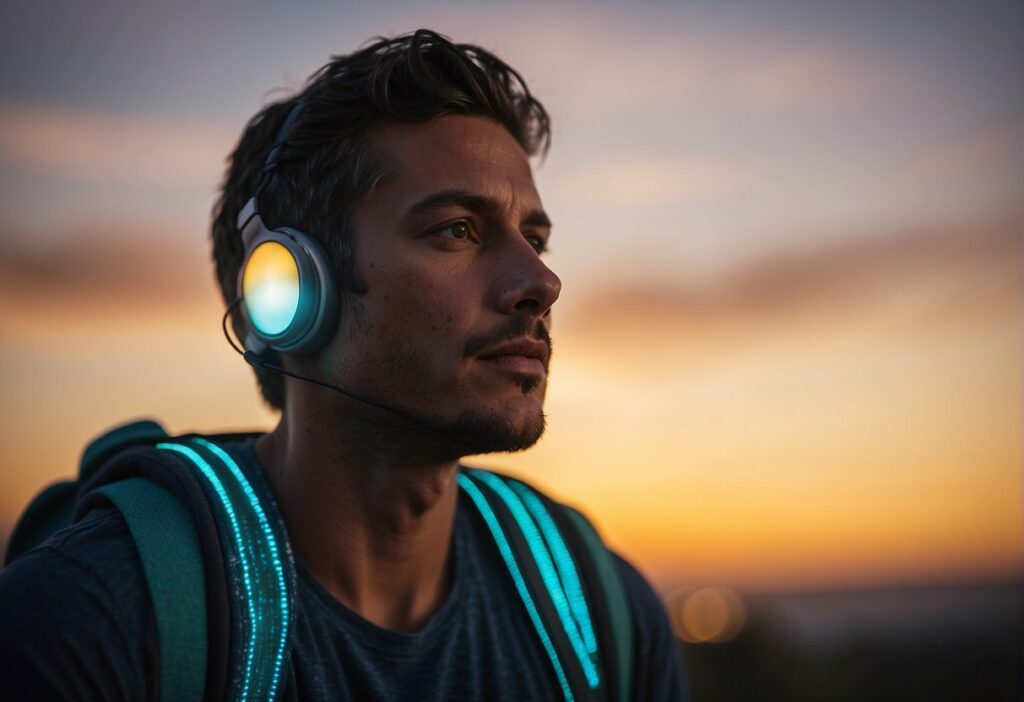The Science Behind Mood-Enhancing Wearables: Assessing Their Real-World Impact

Mood-enhancing wearables represent a burgeoning sector within the health tech industry. These devices incorporate a variety of technologies such as biometric sensors and neurostimulation to purportedly influence the user’s emotional state.
Manufacturers claim that through monitoring physiological markers like heart rate variability, skin temperature, and galvanic skin response, these wearables can detect stress levels and elicit a more positive mood by delivering gentle vibrations, emitting subtle sounds, or even applying small electrical currents to the skin.
The scientific community has taken an interest in quantifying the efficacy of these devices. Several studies have been conducted to evaluate whether such wearables can genuinely alter mood and reduce stress.
Researchers are not only examining direct effects on mood but also potential long-term benefits, such as improved sleep quality, enhanced cognitive function, and overall well-being. They employ rigorous methodologies, including randomized controlled trials and longitudinal studies, to ensure that results are reliable and free from placebo effects.
Consumers, on the other hand, are looking for objective evidence to substantiate these claims. As the market for mood-enhancing wearables expands, it is crucial to distinguish between marketing hype and evidence-based results. This critical evaluation helps inform potential users and guide them towards making well-informed decisions about adopting these technologies for their mental health and emotional well-being.
Theoretical Foundations of Mood-Enhancing Technology

This section explores the core concepts of mood regulation and how wearable technology can monitor and influence an individual’s emotional state through physiological data.
Principles of Mood Regulation
Mood regulation involves a complex interplay of neurotransmitters, hormonal levels, and brain regions such as the amygdala and prefrontal cortex. Key neurotransmitters include serotonin, dopamine, and norepinephrine, which influence feelings of well-being and happiness. For instance:
- Serotonin: Regulates mood, appetite, and sleep; its imbalance is linked to depression.
- Dopamine: Associated with pleasure and reward; its deficiency may lead to feelings of disinterest.
- Norepinephrine: Influences attention and responding actions; its irregularities can affect stress and anxiety levels.
By understanding these principles, developers can design wearables to potentially stabilize mood fluctuations through biofeedback and other strategies.
Wearable Technology and Physiological Monitoring
Wearable technology integrates sensors to collect real-time physiological data, which can include:
- Heart Rate: Variability may indicate stress levels.
- Skin Conductance: Fluctuations can reveal emotional arousal.
- Temperature: Changes can signal stress or relaxation.
These data points provide insights into a user’s emotional state, enabling wearables to deliver tactile feedback, auditory cues, or visual prompts for mood enhancement. For example, a device may suggest a breathing exercise when increased heart rate variability suggests stress. This measured approach to physiological monitoring allows for the personalization of interventions to align with the user’s emotional needs.
Design and Development of Mood-Enhancing Wearables

Mood-enhancing wearables are the convergence of advanced material science and sophisticated design principles, aimed at providing users with a discreet, effective way to manage and improve their emotional states.
Material Science in Wearables
Material selection in mood-enhancing wearables is crucial, as they must be safe for continuous skin contact and have the capacity to house embedded technology. Research on skin-compatible materials like medical-grade silicone and breathable, flexible fabrics leads to wearables that are not only comfortable but also durable. For instance, developers may embed sensors and microprocessors in flexible wristbands that monitor physiological markers like heart rate and skin conductivity, which can indicate emotional arousal.
Manufacturers utilize nanotechnology to design fabrics that can change color or emit soothing temperatures, directly affecting the wearer’s mood. The integration of conductive threads allows for the incorporation of biofeedback mechanisms, which can stimulate the wearer’s skin or release scents to improve mood.
User Interface and Experience Design
The success of mood-enhancing wearables heavily relies on their user interface (UI) and user experience (UX) design. Wearables employ touch screens, voice commands, or gesture controls to enable users to interact with the device with minimal effort.
The UI must be intuitive, allowing users to easily navigate through options, such as selecting a desired mood state or reviewing their emotional trends over time.
Likewise, the UX design must consider the user’s journey from the initial setup to the daily interactions. Developers create accompanying mobile apps that provide detailed analytics and enable seamless synchronization with the wearable.
For example, well-designed graphs and charts can track and display the users’ mood fluctuations alongside relevant environmental or physiological data, enabling users to understand and manage their emotions more effectively.
Clinical Research and Trials

In assessing mood-enhancing wearables, rigorous clinical research and trials are paramount. They provide a structured approach to validate the effectiveness of these devices through empirical evidence.
Study Design and Methodology
Objective: To determine the efficacy of mood-enhancing wearables.
- Participants: A diverse demographic of individuals experiencing mood fluctuations.
- Intervention: Regular use of mood-enhancing wearables.
- Comparison: A control group not using wearables.
- Outcome Measures: Changes in mood, stress levels, and overall emotional well-being.
Clinical trials typically involve a randomized controlled trial (RCT), which is considered the gold standard in clinical research. This design minimizes bias and allows for a clear comparison between the intervention group and the control group. The methodology must be clearly defined, with inclusion and exclusion criteria specified to ensure a representative sample.
Data Collection and Analysis
Data Collection:
- Structured surveys
- Psychological assessments
- Physiological measurements (heart rate, cortisol levels)
Analysis: To ensure reliability and validity, data collected from trials is subjected to statistical analysis. This may include the use of:
- Descriptive statistics
- Inferential tests (e.g., t-tests, ANOVA)
- Regression models
The data analysis is critical for interpreting the effects of wearables on mood. Researchers look for statistically significant differences between groups to ascertain the impact of the mood-enhancing device. Careful data handling and analysis are necessary to conclude the device’s efficacy accurately.
Real-World Applications and Case Studies

The adoption of mood-enhancing wearables has been illustrated through a range of consumer products and therapeutic interventions. These examples showcase their practical use and the impact they have on user well-being.
Consumer Products
Mood-Enhancing Wearable Devices:
- Thync: This device uses low-level electrical stimulation to help users achieve a state of calm or increase their energy levels.
- Feel: A wristband tracking emotional states by measuring physiological markers, providing users with data to understand and improve their mood.
Mobile Applications:
- MoodKit: Integrates with wearable technology to track mood and provides tools for mood improvement based on cognitive-behavioral therapy principles.
- Happify: Uses evidence-based activities aimed at increasing positive feelings when synchronized with wearable mood trackers.
Therapeutic Interventions
Clinical Trials:
- A study published in the Journal of Affective Disorders found that patients with depression showed significant improvement when using mood-enhancing wearables alongside traditional treatment.
- Research in NeuroRegulation indicated that wearable devices could reduce anxiety in autistic individuals, demonstrating the devices’ therapeutic potential beyond general wellness.
Hospital Programs:
- The Mayo Clinic introduced wearables in their stress reduction program, where patient monitoring showed a decrease in reported stress levels post-intervention.
- At Boston’s Beth Israel Deaconess Medical Center, wearables are being tested to enhance patient recovery in psychiatric units by offering real-time mood regulation guidance.
Challenges and Ethical Considerations

In exploring the efficacy of mood-enhancing wearables, it is imperative to consider the associated challenges and ethical implications, particularly in the realms of privacy and adherence to regulatory standards.
Privacy and Data Security
Mood-enhancing wearables rely on the collection of personal data, such as physiological responses and mood indicators. Ensuring user information remains confidential presents a major challenge. Manufacturers must implement robust encryption and secure data storage techniques to protect against unauthorized access or breaches. They should be transparent about:
- What data is collected
- How it is used
- With whom it is shared
Regulatory Compliance
Given that mood-enhancing wearables can intersect with medical devices, they may fall under stringent regulations. Companies must navigate through a complex landscape of laws that safeguard consumer safety and product efficacy. Compliance is mandatory for:
- Approval processes: Devices may require validation from entities like the FDA.
- Marketing claims: Statements about benefits must be supported by scientific evidence.
